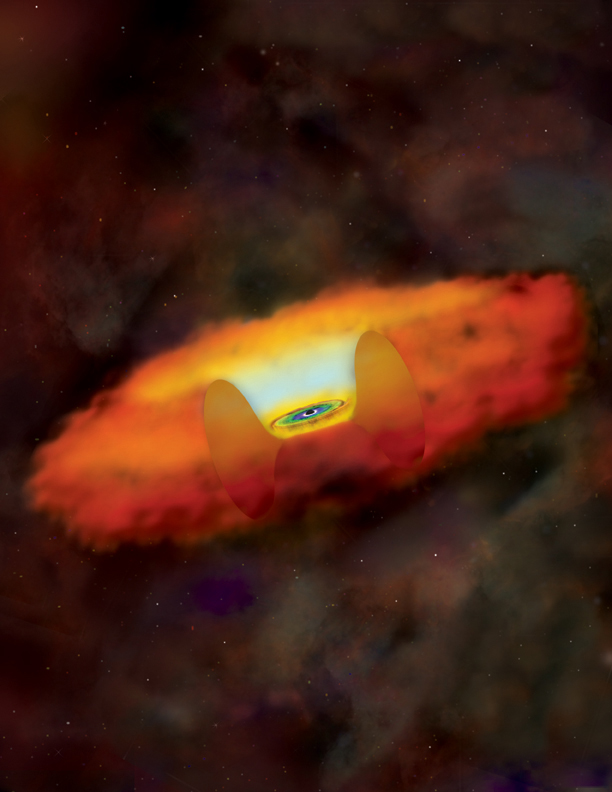Astronomers using NASA's Chandra X-ray Observatory and the 6.5-meter Clay Telescope in Chile have identified the smallest supermassive black hole ever detected in the center of a galaxy, as described in our latest press release. This oxymoronic object could provide clues to how much larger black holes formed along with their host galaxies 13 billion years or more in the past.
Astronomers estimate this supermassive black hole is about 50,000 times the mass of the Sun. This is less than half the previous lowest mass for a black hole at the center of a galaxy.
The tiny heavyweight black hole is located in the center of a dwarf disk galaxy, called RGG 118, about 340 million light years from Earth. Our graphic shows a Sloan Digital Sky Survey image of RGG 118 and the inset shows a Chandra image of the galaxy's center. The X-ray point source is produced by hot gas swirling around the black hole.
Researchers estimated the mass of the black hole by studying the motion of cool gas near the center of the galaxy using visible light data from the Clay Telescope. They used the Chandra data to figure out the brightness in X-rays of hot gas swirling toward the black hole. They found that the outward push of radiation pressure of this hot gas is about 1% of the black hole's inward pull of gravity, matching the properties of other supermassive black holes.

Artist's Illustration of Black Hole
Previously, a relationship has been noted between the mass of supermassive black holes and the range of velocities of stars in the center of their host galaxy. This relationship also holds for RGG 118 and its black hole.
The black hole in RGG 118 is nearly 100 times less massive than the supermassive black hole found in the center of the Milky Way. It is also about 200,000 times less massive than the heaviest black holes found in the centers of other galaxies.
Astronomers are trying to understand the formation of billion-solar-mass black holes that have been detected from less than a billion years after the Big Bang. The black hole in RGG 118 gives astronomers an opportunity to study a nearby small supermassive black hole in lieu of the first generation of black holes that are undetectable with current technology.
Astronomers think that supermassive black holes may form when a large cloud of gas, weighing about 10,000 to 100,000 times that of the Sun, collapses into a black hole. Many of these black hole seeds then merge to form much larger supermassive black holes. Alternately, a supermassive black hole seed could come from a giant star, about 100 times the Sun's mass, that ultimately forms into a black hole after it runs out of fuel and collapses.
Researchers will continue to look for other supermassive black holes that are comparable in size or even smaller than the one in RGG 118 to help choose between the two options mentioned above and refine their understanding of how these objects grow.
A preprint of these results is available online. The other co-author of the paper is Jenny Greene, from Princeton University in Princeton, New Jersey. NASA's Marshall Space Flight Center in Huntsville, Alabama, manages the Chandra program for NASA's Science Mission Directorate in Washington. The Smithsonian Astrophysical Observatory in Cambridge, Massachusetts, controls Chandra's science and flight operations.
This image reveals a tiny heavyweight black hole located in the center of a dwarf disk galaxy, called RGG 118, about 340 million light years from Earth. The main panel is a Sloan Digital Sky Survey optical image of RGG 118, and there is an inset at upper right with a Chandra X-ray Observatory image of the galaxy's center. The X-ray point source, colored in purple, is produced by hot gas swirling around the black hole. The dominant colors in the optical image are greyish brown, blue and white, all on black. The key structures in the optical image include a bright white spot in the center of the galaxy, with a couple fuzzy unstructured arms around it, surrounded by many smaller speckles or fuzzy dots. Researchers used the Chandra data to figure out the brightness in X-rays of hot gas swirling toward the black hole. The outward push of radiation pressure of this hot gas is about 1% of the black hole's inward pull of gravity, matching the properties of other supermassive black holes.
|
||||||||||||||||||||||||||||||


